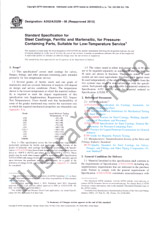Potřebujeme váš souhlas k využití jednotlivých dat, aby se vám mimo jiné mohly ukazovat informace týkající se vašich zájmů. Souhlas udělíte kliknutím na tlačítko „OK“.
ASTM E2684-17
Standard Test Method for Measuring Heat Flux Using Surface-Mounted One-Dimensional Flat Gages
Přeložit název
NORMA vydána dne 1.9.2017
Informace o normě:
Označení normy: ASTM E2684-17
Poznámka: NEPLATNÁ
Datum vydání normy: 1.9.2017
Kód zboží: NS-797374
Počet stran: 7
Přibližná hmotnost: 21 g (0.05 liber)
Země: Americká technická norma
Kategorie: Technické normy ASTM
Kategorie - podobné normy:
Anotace textu normy ASTM E2684-17 :
Keywords:
heat-flux gage, temperature gradient, thermal transport,, ICS Number Code 17.200.10 (Heat. Calorimetry)
Doplňující informace
| Significance and Use | ||||||
|
5.1 This test method will provide guidance for the measurement of the net heat flux to or from a surface location. To determine the radiant energy component the emissivity or absorptivity of the gage surface coating is required and should be matched with the surrounding surface. The potential physical and thermal disruptions of the surface due to the presence of the gage should be minimized and characterized. For the case of convection and low source temperature radiation to or from the surface it is important to consider how the presence of the gage alters the surface heat flux. The desired quantity is usually the heat flux at the surface location without the presence of the gage. 5.1.1 Temperature limitations are determined by the gage material properties and the method of application to the surface. The range of heat flux that can be measured and the time response are limited by the gage design and construction details. Measurements from 10 W/m2 to above 100 kW/m2 are easily obtained with current sensors. Time constants as low as 10 ms are possible, while thicker sensors may have response times greater than 1 s. It is important to choose the sensor style and characteristics to match the range and time response of the required application. 5.2 The measured heat flux is based on one-dimensional analysis with a uniform heat flux over the surface of the gage surface. Because of the thermal disruption caused by the placement of the gage on the surface, this may not be true. Wesley (5.3 Measurements of convective heat flux are particularly sensitive to disturbances of the temperature of the surface. Because the heat transfer coefficient is also affected by any non-uniformities of the surface temperature, the effect of a small temperature change with location is further amplified, as explained by Moffat et al. (5.3.1 Fig. 2 shows a heat-flux gage mounted onto a plate with the surface temperature of the gage of Ts and the surface temperature of the surrounding plate of Tp. The goal is to keep the gage surface temperature as close as possible to the plate temperature to minimize the thermal disruption of the gage. This requires the thermal resistance of the gage and adhesive to be minimized along the thermal pathway from Ts and Tp. FIG. 2 Diagram of an Installed Surface-Mounted Heat-Flux Gage 5.3.2 Another method to avoid the surface temperature disruption problem is to cover the entire surface with the heat-flux gage material. This effectively ensures that the thermal resistance through the gage is matched with that of the surrounding plate. It is important to have independent measures of the substrate surface temperature and the surface temperature of the gage. The gage surface temperature must be used for defining the value of the heat-transfer coefficient. When the gage material does not cover the entire surface, the temperature measurements are needed to ensure that the gage does indeed provide a small thermal disruption. 5.4 The time response of the heat-flux
gage can be estimated analytically if the thermal properties of the
thermal-resistance layer are well known. The time required for 98 %
response to a step input (where α is the thermal diffusivity of the
TRL. Covering or encapsulation layers must also be included in the
analysis. Uncertainties in the gage dimensions and properties
require a direct experimental verification of the time response. If
the gage is designed to absorb radiation, a pulsed laser or
optically switched Bragg cell can be used to give rise times of
less than 1 μs (5.4.1 Because the response of these
sensors is close to an exponential rise, a measure of the time
constant τ for the sensor can be obtained by matching the
experimental response to step changes in heat flux with exponential
curves. 1.2 This test method is quite broad in its field of application, size and construction. Different sensor types are described in detail in later sections as examples of the general method for measuring heat flux from the temperature gradient normal to a surface (1.3 The values stated in SI units are to be regarded as the standard. The values stated in parentheses are provided for information only. 1.4 This standard does not purport to address all of the safety concerns, if any, associated with its use. It is the responsibility of the user of this standard to establish appropriate safety and health practices and determine the applicability of regulatory limitations prior to use. 1.5 This international standard was developed in accordance with internationally recognized principles on standardization established in the Decision on Principles for the Development of International Standards, Guides and Recommendations issued by the World Trade Organization Technical Barriers to Trade (TBT) Committee. |
||||||
| 2. Referenced Documents | ||||||
|
Doporučujeme:
Aktualizace technických norem
Chcete mít jistotu, že používáte pouze platné technické normy?
Nabízíme Vám řešení, které Vám zajistí měsíční přehled o aktuálnosti norem, které používáte.
Chcete vědět více informací? Podívejte se na tuto stránku.




 Cookies
Cookies
